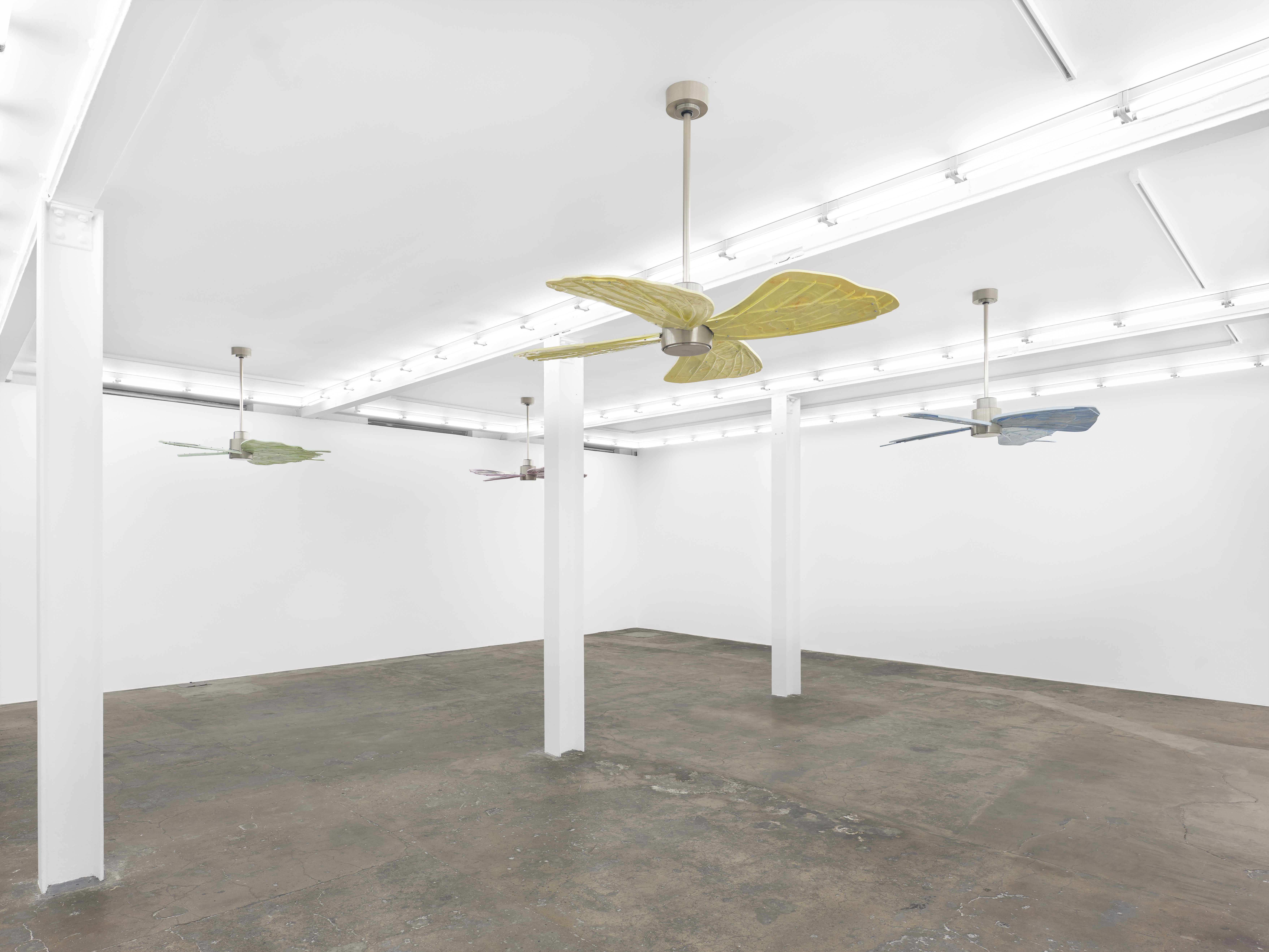Olivia Erlanger continues her ongoing investigation into the history and semiotics of appliances with Fan Fiction, an exhibition of four ceiling-fan sculptures whose blades have been altered to resemble butterfly wings. In her practice, Erlanger has deconstructed the idea and function of appliances to demonstrate how their development has shaped suburbia, both internally and externally. These new works build on the artist’s interest in “closed worlds”, a term created by architectural theorist Lydia Kallipoliti for describing man-made, climate-controlled environments that exist to the detriment and obfuscation of an outside, so-called natural world.
Within this framework, the ceiling fan can be seen as an early technology that creates the illusion of cooling, not by changing temperature but rather by controlling airflow. In this way, Erlanger ties the idea of closed worlds to this disjunct between a natural world and controlled interior environment. As Rem Koolhaas described it in “Junkspace” (2002), “air-conditioning—invisible medium, therefore unnoticed—has truly revolutionised architecture. Air conditioning has launched the endless building. If architecture separates buildings, air-conditioning unites them.” And yet, Erlanger’s fans don’t even create a cooling effect—and having different wing patterns in place of blades, they also don’t unite the space. By setting these “appliances” to the lowest possible speed, she seeks to have them impersonate their functional cousins.
Erlanger frustrates our desire to control the speed of the sculptures’ rotations and so exasperates our inherent fixation with constructing an internal environment to suit our physical desires. In Fan Fiction, Erlanger’s sculptures betray the artifice of closed worlds—and poke fun at the incredible lengths we’ll go to to make them. This notion similarly reveals the lack of sensitivity or awareness with which humanity approaches its ability to alter interior spaces and what the impact of this may be on the biosphere. In the gallery, fan speed cannot be adjusted, and in her short film Appliance (2024), Erlanger depicts disorderly appliances that haunt and undermine her protagonist’s capacity to live comfortably after she moves into a new home. An oven, a lamp, the fridge: each object in the film appears to reject its prescribed purpose, and in doing so, leads the new tenant to question her grasp on reality.
Appliance extends Erlanger’s interest in horror films set in American suburbia, and when viewed in the context of Fan Fiction, engenders the butterfly sculptures with an undertone of danger and violence of their own. Engaging a trope within the horror genre known as “ceiling fan death” or the “killer ceiling fan”, Erlanger revisits her continuing transformation of prosaic and mundane objects and architectures into the fantastic and to allude to the etymology of terror.
Erlanger has chosen butterfly patterns that represent a phenomenon known as Batesian mimicry, wherein non-poisonous species have evolved to imitate the traits of toxic ones—to avoid being eaten by their predators. For Erlanger, this complex correlates to strategies of sociopolitical adaptation, wherein external conditions precipitate larger transformations. In the exhibition, the artist humorously addresses this tendency by disguising her sculptures as familiar household commodities. To reinforce their artificiality, the works reassemble pre-existing, prefabricated domestic technologies including shower rods, kitchen utensil holders, ceiling fan cans and waste-paper bins.
The sculptures are arranged as a quadrilateral, generating an axis from which Erlanger plots her titling. In Greek mythology, the four gods of wind each correlate to a cardinal direction—North, South, East and West, or Boreas, Notus, Eurus and Zephyrus, to create a kind of compass within the gallery space. The Greeks gave human form to a natural phenomenon like the wind—a continuation of their attempt to control nature via an anthropomorphizing impulse, much like Erlanger does with her zoomorphic fans. Named after these gods and followed by the serial numbers of the original fans used in the fabrication process, these titles represent a return to Erlanger’s concern with nomenclature that reflects orientation, or how we locate ourselves within space, and returns us to her interest in scaling the home to represent a body, a neighbourhood, a planet.

